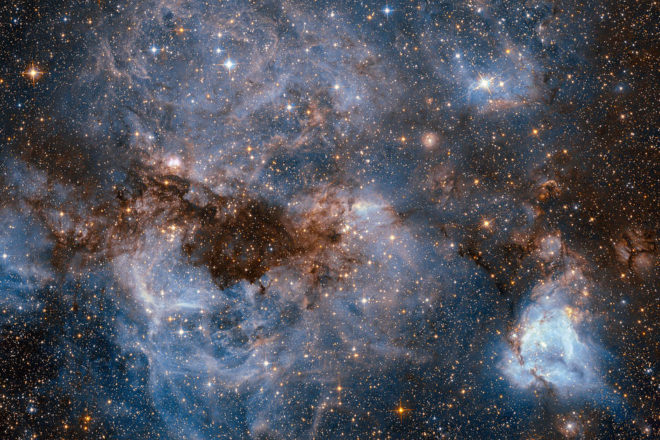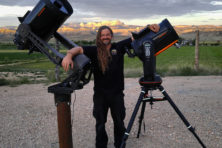Light Pollution and Dark Sky Parks
- Share
- Tweet
- Pin
- Share

by Tom Minahan
The mission of the International Dark-Sky Association (IDA) “… is to preserve and protect the nighttime environment and our heritage of dark skies through environmentally responsible outdoor lighting.”
Light pollution is a serious problem not just for astronomers. It wastes energy, affects crime and safety, and disrupts the ecosystem and wildlife. This is especially true for flowering plants and nocturnal animals, including humans. Poorly shielded outdoor lighting is also just annoying! The fight against light pollution is a huge challenge because the world population keeps growing and the demand for outdoor lighting increases proportionately. But the problem can be allayed with wise decisions by municipalities and city planners and the design and use of smarter nighttime lighting.
Light pollution is the “inappropriate or excessive use of artificial light,” which includes glare, skyglow, light trespass and clutter. Glare is the visual discomfort caused by bright and poorly shielded outdoor lighting, which reduces or eliminates the visibility of one’s surroundings. This is particularly hazardous when driving. Skyglow is the brightening of the night sky over populated areas. This is the enemy of astronomers because the excess light is the random noise to the signal of light from an astronomical target. Light trespass is light directed where it is not needed or wanted. If you live near an over-lit auto lot or across the street from a farmyard illuminated by an omnidirectional nova, you understand. When lights are placed too close together or are excessively bright together, the resulting clutter tends to distract. Satellite maps of the nighttime Earth are a good way to grasp the extent of light pollution across the globe.
Light pollution is not just wasteful but harmful to people and ecosystems. Inefficient and poorly-aimed outdoor lighting wastes the light and the energy needed to produce it. Wasted light is light that shines up into the sky or any light that doesn’t directly illuminate the ground. According to futurism.com, an estimated 30 percent of street light is wasted. This translates into 22,000 gigawatt-hours, or $2.2 billion a year wasted in the United States alone. According to several studies cited by the IDA, there is no clear scientific evidence that increased outdoor lighting deters crime. Bad outdoor lighting decreases safety by making victims and property easier to see, and glare can allow perpetrators to hide in the unseen background of a blinding street or house light.
Inappropriately bright outdoor lighting near orchards disrupts the normal timing of spring blossoming and entire crops can be lost if the plants are induced to bloom before the last spring frost. And, according to placesjournal.org, researchers at the University of Haifa found “an elevated incidence of breast cancer in women who live in light-saturated neighborhoods. They suggest that artificial nighttime lighting may interfere with the brain’s production of melatonin, a tumor-suppressing hormone.” This is just a sampling of the harmful effects of light pollution.
Strategies are being used to reduce light pollution that include, among others, encouraging municipalities to use full-cutoff streetlights for new and replacement outdoor lighting. What can you do to reduce light pollution at your home or place of work? Replace or shield lights that emit light out and up so all the light shines downward – it’s that simple!
The problem of light pollution is pervasive in all developed areas, but there are still some spots where skies are mostly free of skyglow.
Skyglow is a measure of the brightness of the night sky overhead; it is easier to see the stars with a less bright sky. A quantitative measure of the darkness of a local sky is done with a Sky Quality Meter, which precisely measures the amount of ambient light directly overhead, and by observing the dimmest stars you can see (not near the horizon) and obtaining their magnitude from a sky chart. Magnitude is a measure of a star’s brightness on a scale where larger magnitudes are dimmer. For example, Betelgeuse in Orion has mag = +0.42 and the stars in the Big Dipper range from about +2 to +3.31. Every visible star has been assigned a magnitude (some are variable) and these are published widely. If an area has a metered darkness reading >21.75 and stars of magnitude 6.8 or greater are visible, then that area qualifies for Gold Tier Designation by the IDA. These areas are considered to be “nighttime environments that have negligible … impacts from light pollution.” and many have been designated International Dark Sky Places, which include parks, communities and sanctuaries. There are more than 90 in the world.
Did you know that we in Door County have an official Dark Sky Park at Newport State Park? Far from towns and surrounded by forests and Lake Michigan, Newport enjoys exceptionally dark skies and good atmospheric “seeing.” Designated as an International Dark Sky Park by the IDA in June 2017, it is the only such locale in Wisconsin. If you are an amateur astronomer, Newport is obviously a choice place to set-up on a clear night, but you don’t need a telescope or binoculars to experience the wonder of the Milky Way in clarity. If you are a city dweller and have rarely, if ever, been “in the wilderness” at night, you will experience a feast for the eyes.
Newport State Park is located at the northeast tip of the Door Peninsula at 475 Cty NP. Newport offers backpack camping only and all campsites are hike-in and supplies must be carried in and out. See dnr.wi.gov for more information and ReserveAmerica.com to make reservations.
Join members of the Door Peninsula Astronomical Society for 5 Nights Under Dark Skies on the evenings of August 10-14, 2018 at Newport State Park. A variety of telescopes and binoculars will be available in the designated viewing area. Guests are invited to bring cameras or smartphones to capture images of magnified views of astronomical targets. Viewing will begin each night an hour before dark because planets are frequently visible before then. If skies are overcast, a program or video of astronomical interest will be shown in the A/V shelter.
“Eye On the Night Sky” is a monthly column by the Door Peninsula Astronomical Society. For more information on the organization, visit DoorAstronomy.org.



